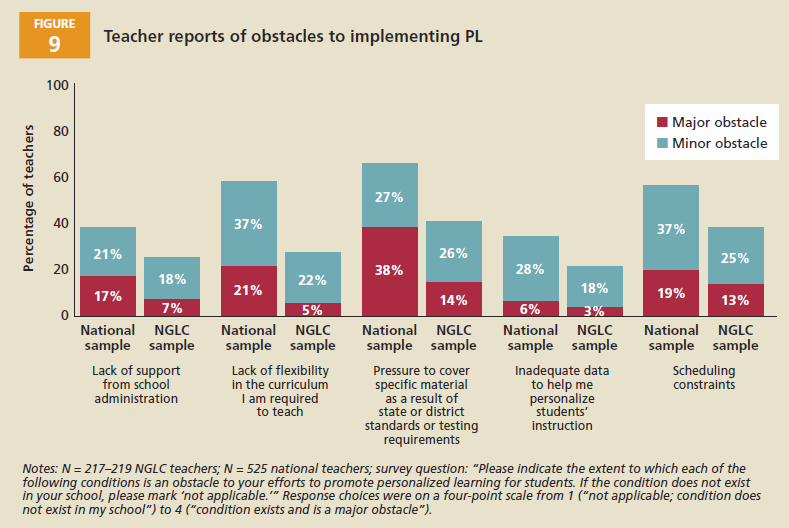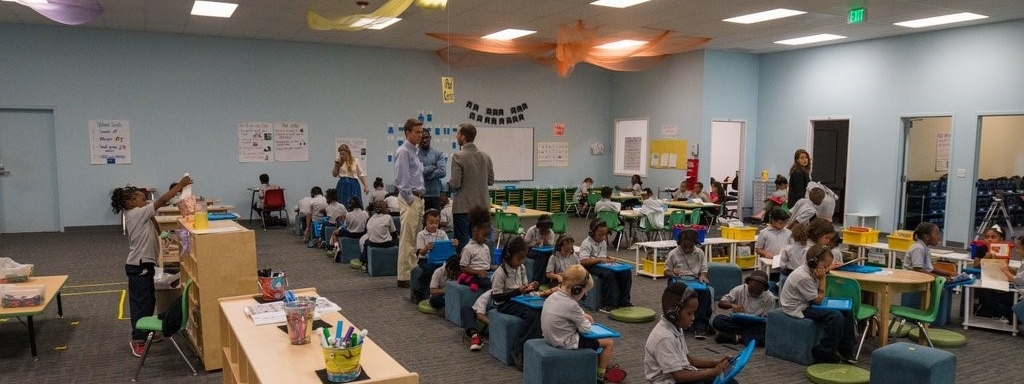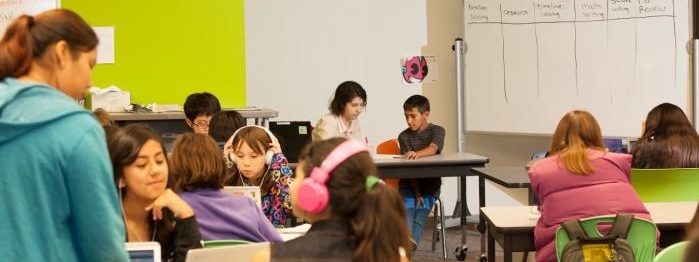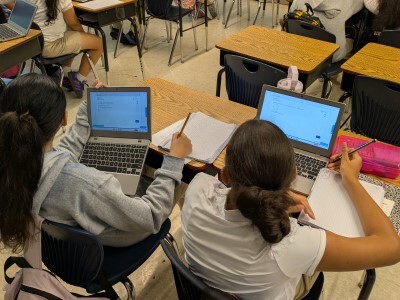Reflecting on Personalized Learning Research: What We Think, What We Wonder
Topics

We’ve all had the experience of truly purposeful, authentic learning and know how valuable it is. Educators are taking the best of what we know about learning, student support, effective instruction, and interpersonal skill-building to completely reimagine schools so that students experience that kind of purposeful learning all day, every day.
Practitioner's Guide to Next Gen Learning
This inquiry into recent personalized learning research takes a practitioner's lens to extend beyond "what we know" by drawing reasonable inferences and raising thoughtful questions about the findings.
As any researcher can tell you, many factors constrain what a research report can legitimately conclude. For example, a study’s sampling size, duration, and the type of data collected make it challenging to tease out definitive causes—especially in a field as multidimensional as education. Researchers must therefore couch many of their findings and recommendations with qualifiers like “suggests” and “may be related” or caveats about the need for further investigation. In my own career as an educator, new research has often prompted me to ask, “What does this mean for me and my students?”
As schools across the country gear up for a new academic year, practitioners look to research to provide some indication that their hard work reimagining schools is on the right track and guidance on where to go next. Last month, the RAND Corporation released a new report of their study of schools funded through Next Generation Learning Challenges (NGLC): Informing Progress: Insights on Personalized Learning Implementation and Effects. The NGLC team previously discussed its key findings in “Personalized Learning is (Again) Promising: A Snapshot of Practice & Student Achievement.” This edition of NGLC’s Practitioner’s Guide to Next Gen Learning extends our inquiry beyond What We Know (the actual findings of the RAND study) to explore:
What We Think: Reasonable and actionable inferences to inform practitioners’ mindset and decision-making, and
What We Wonder: Ideas and questions prompted by the report to provoke discussions and further inquiry as systems, schools, and classrooms rethink teaching and learning.
What We Think #1:
PL improves student learning, and the more deeply it informs your practice, the better the learning.
We begin with this “thought” because it is the prerequisite for all of the discussion that follows. From an educator perspective, unless we think personalized learning (PL) works better for students—all students—considerations like degree of implementation, overcoming barriers, use of tools to support this work, etc. have little utility.
All three of the reports published out of RAND’s study point to the promise of PL. Moreover, reading and math NWEA/MAP scores showed gains from the lowest- through the highest-performing students: “across the achievement spectrum, more than half of NGLC students surpassed their comparison students. This suggests that PL is benefiting students of all ability levels” (p. 37). In other words, these findings lead to the reasonable and actionable inference that tailoring learning to meet each learner’s needs is indeed a worthy goal, one we should keep pursuing to support the achievement of all students.
Two other findings in the report further bolster our confidence in the value of PL. Both consider the degree of a school or system’s engagement with personalized learning. The short answer is: the more we engage with PL, the better.
- More time - The majority of participating NGLC schools were either new or just embarking on their personalized learning journeys at the time of this study, so only a subset had two years’ worth of achievement data. Still, the researchers found that, “the largest gains on average appeared to occur in the second year, suggesting that PL systems may require some experience before operating at their fullest potential” (p. 35). In short, these findings signal a kind of PL learning curve with increasing benefit over time.
Degree of engagement - A second result deals with how deeply the PL practices are integrated into the fabric of the school’s model. Though the authors consider this finding more speculative, they do point to “suggestive evidence that greater implementation of PL practices may be related to more-positive effects on achievement.” (p. 41)
At the risk of oversimplifying, what we think is that personalized learning supports student achievement better than traditional, one-size-fits-all models. This transformation is not quick or easy, but making the effort to do PL well and deeply will pay off in increasing levels of student success over time.

The study’s achievement findings also prompt some wondering, and we invite you to reflect on these questions with your stakeholders, and with the NGLC community.
What we wonder: what is actually happening over time? The more pronounced achievement gains in the second year of PL implementation highlight the possibilities for further growth as school models and practices are refined. But how much of the learning curve is student capacity to learn this way and how much is educator capacity to teach this way? How we answer that question has implications for improving our design over time. How much support do students need to develop skills like collaboration, problem-solving, self-management, and goal setting in order to get the most from a personalized, student-centered model? And if we are asking educators to transform their teaching roles and methods, what professional learning experiences can we provide to support that transformation?
What we wonder: what factors are we not considering? The RAND study acknowledges that other characteristics of NGLC schools, ones that were not part of this study, may also contribute to student achievement. Given what we know about NGLC schools, this is a useful question. The elements RAND studied—learner profiles, personal learning paths, competency-based progression, and flexible learning environments—are indeed central to many models, but these four pillars do not capture the breadth and depth of the next generation learning we observe in the field. For instance, the study does not address the role of engagement with real-world learning experiences, social-emotional learning, profound commitment to equity, or cultivation of community and student belongingness, essential aspects of so many NGLC school designs. To what extent do these, working in concert with personalized learning, support student success?
What We Think #2:
PL is challenging to implement well and deeply, but flexibility is key.
Of the four PL elements explored in the study, flexibility of learning environments was one area in which NGLC schools differed substantially from the national comparison sample. The term “learning environment” refers to how schools use space, time, staff, and other resources. Specifically, the report identified NGLC schools’ greater use of open and flexible spaces to support fluid learning configurations, more frequent changes in the makeup of student groups in response to data, and schedules that were more likely to include built-in time for one-on-one student support. Among charter schools in particular, these areas of flexibility were supplemented with nontraditional roles for adults, such as co-teaching, job-sharing, and use of noncertified staff as advisors and mentors.
In addition to highlighting greater flexibility among NGLC schools, the RAND study found that teachers in NGLC schools experienced fewer obstacles to implementing PL:

The report treats “greater flexibility” and “fewer obstacles” as separate topics and does not draw a line to connect the two ideas, but it’s a reasonable and actionable inference to think they are related. New ways of learning require new ways of teaching, often incompatible with the tools and structures of the past. Use of technology tools, innovative classroom configurations, and schedules tailored to student needs will not by themselves create PL any more than setting up a recording studio will create music. However, given the promise of PL for student achievement, removing as many constraints as possible seems to be a good starting place. The more flexibility we have in what we think about the learning environment, the easier it will be to make student learning, not past practice, the north star of our decision-making.
What we wonder: how might we use our resources of space, time, and staff to reimagine the learning experience? Though it’s certainly easier to design for flexibility with the blank canvas of a new school, NGLC partners are coming up with creative ways to optimize existing resources. For example, if we let go of the mental picture of a traditional classroom, might we find spaces in our school to repurpose as learning environments for student collaboration, one-on-one support, or teacher co-planning? Even something as simple as assigning adjacent grade levels to adjacent rooms could facilitate nontraditional, cross-grade grouping. Are there ways we might also “disrupt” traditional scheduling to include project time, multi-day intensives, or use technology tools to support anytime/anywhere learning?

Removing barriers also includes ones of mindset, mental constraints of our own making. How many times have you heard comments like, “That might work for them, but it could never fly here”? Or “I’d like to try that, but my principal/students/parents wouldn’t accept it”? If you mean springing a drastically different practice on your stakeholders without warning, you are probably right. But based on the experiences of NGLC grantees, we are amazed by what can happen when innovations emerge organically from community engagement. If we start with a vision of student success shared by educators, students, and families, innovations to the learning environment that seemed radical at first may suddenly be perceived as “creative solutions” or even plain old common sense.
What We Think #3:
The right tools can help educators surmount barriers to personalizing learning.
Once you have co-created your definitions of student success, removed as many of the barriers to innovation as you can, and are ready to transform your school, the right tools can help make possible some of your goals for student learning. The RAND study looked specifically at the technology tools used to support PL. Another notable difference between the NGLC schools and the comparison sample was more frequent use of technology to support personalized learning practices:

Perhaps what’s worth thinking about in this chart is not how much technology is used but how—what is happening in schools and how can technology solutions make that work easier? As the report authors put it, “one theoretical hope is that technology can help make implementation of PL—and personal learning paths in particular—more efficient.” (p. 15) In other words, use of technology is not the goal, but once educators identify challenges in implementing deeper, more personalized learning, it can offer solutions for meeting those challenges.
For example, tech-enabled, on-demand assessment gives students more opportunities to demonstrate mastery so they can progress in their learning as soon as they are ready. Frequent access to data allows educators to update learner profiles, provide timely intervention or enrichment, and adjust grouping and/or pacing in response to student needs. Online content, such as curated playlists, can customize the learning experience by offering greater student choice in learning activities. Technology can also minimize the constraints of time, space, and staff by providing anytime/anywhere learning and access to experts both in and out of the school setting.
However, even though we think technology can play a key role in overcoming obstacles to PL, it is a means and not an end. Providing students with tablets does not create a personalized, student-centered environment any more than handing out GPS devices and parkas creates an arctic expedition. Having the right equipment may make the journey less arduous, but it won’t get us to our goal. Though technology may help deliver playlists and assessments, it’s the quality and pedagogical soundness of the playlists and assessments that matters.
What we wonder: what is the sweet spot regarding how much technology and for what purposes? With so many shiny new technology solutions on offer, it’s easy to get distracted from our goals for student success. And given the demands on educators’ time, what is the balance between having a wide array of tools and fully leveraging, training, and supporting the ones you have?
How might we take advantage of technology’s particular strengths to address the more labor-intensive practices of personalized learning? Consider the power of crowdsourcing, for example. Instead of requiring each educator or school to create playlists, how might school networks and collaboratives work together to build a shared library with enough standards-aligned content to offer student choice without overwhelming teachers?
What we wonder: what about more elusive kinds of data? According to the RAND report, accessing achievement data was not a significant roadblock for educators in the study. However, data around social-emotional learning, habits for success, and other non-academic indicators tend not to be integrated with existing data systems. How might educators keep these important but harder-to-measure elements of students’ learning front and center? How do we provide time and professional learning to support educators as they interpret the data and take action? What role might students play in co-creating assessments or accessing and interpreting their own data?
What We Think #4:
A next gen learning ecosystem is greater than the sum of its parts.
Near the end of the RAND report, in a section devoted to implications and recommendations, the authors write, “although early evidence suggests that these PL approaches may be quite promising for improving achievement for a broad range of students, at this early stage in the development of the innovation it is not clear what PL practices or combination of practices have the greatest impact on students” (p. 41). In essence, we think PL is good for students, but we don’t yet know which practices are responsible. From the standpoint of a practitioner, as opposed to a psychometrician, the operative phrase here for a reasonable and actionable inference is “combination of practices.”

What we wonder: how might a common vision and shared goals amplify the effects of PL practices? Many schools, including ones in the study’s national sample, have adopted discrete elements of PL. Though it is reasonable to ask “which ones work?” we wonder about the role of context, synergy, and the qualities of the entire learning ecosystem. How, for example, does creating a community-wide vision of student success drive change? What about the energy and zeal generated by working together toward the common goal of getting personalized learning right (and right for all students)? Is implementing next generation learning like synchronized swimming: each athlete’s “move” is executed with excellence, but it’s the choreography, design, and coordination of the team that take our breath away?
What we wonder: what about mindset? Though it’s difficult to quantify, mindset is relevant to any discussion of effecting transformational change. We wonder about how rethinking teaching and learning serves as a necessary first step in our transformation journey: how might a personalized, student-centered mindset engender a culture of innovation whose impact surpasses the effects of the individual practices?
For guidance, we might look to what we’ve learned about mindsets for health and wellness. The foundation for a healthy lifestyle is not a particular workout routine or brand of prepackaged meals. Though wellness is built on some common principles regarding diet, exercise, and rest, the pursuit of it does not look the same for everyone. What it does require from all of us is a commitment to a new, healthier way of thinking and living, a new lens for evaluating options and making decisions everyday. The work of transforming schools is not so different...and certainly no less important.




